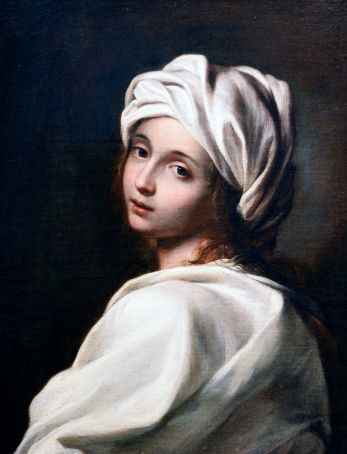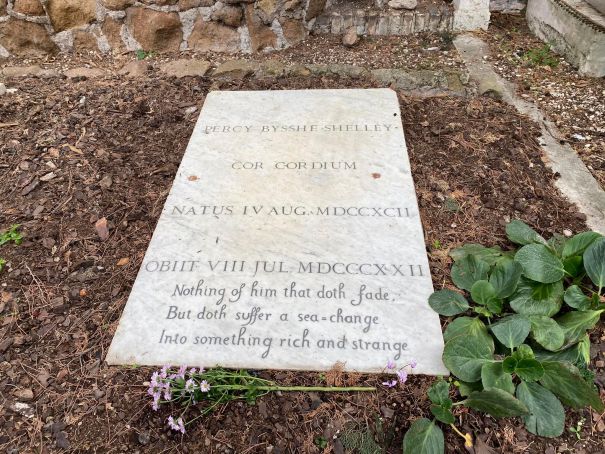The Keats-Shelley House in Rome marks the 200th anniversary of the drowning of Percy Bysshe Shelley with a series of events.
The three months that Percy and Mary Shelley and Mary's half sister Claire Clairmont spent in Rome between March and June 1819 started happily but ended in the tragic and sudden death of William, Percy and Mary's son, on 7 June.
The three of them buried the three-year-old Willmouse in the Non-Catholic Cemetery and then fled the city. Percy was never to return. Just over three years later, after drowning off the coast of Lerici in Tuscany on 8 July 1822, his ashes were brought back to Rome to be buried in the same cemetery.
This year the Keats-Shelley House is marking the 200th anniversary of the poet's death with a series of events in Rome, Naples, Lerici and the United Kingdom. One of the first events was a video made for the Keats-Shelley House in Rome by the production company 313 which was screened on the façade of the House in Piazza di Spagna on 19 February.
Arrival in Rome
The Shelleys arrived in Rome after a difficult and emotionally draining time in Naples. Percy and Claire had been ill, but the real reason for the tension was the birth of a baby girl, Elena Adelaide, who Percy registered as his and Mary's. There is little question that Percy was the father, but Mary was certainly not the mother. Why then did she allow her name to be used in the registration? This mystery has never been solved.
Some gossip at the time, especially coming from Lord Byron's entourage, pointed the finger at Claire. But the Shelleys maintained that Elena was the daughter of their servant Elize. Whatever the truth of the matter, Percy always intended to return to Naples to collect Elena from her foster parents. But tragically Elena died on 9 June 1820 before Percy was able to return to Naples. It is doubtful that if Claire had been the mother she would have shown so little emotional interest in the child, especially as she had recently given her daughter, Allegra, over to the guardianship of the father, Lord Byron, and clearly regretted the decision.
Inspired by Rome
The Shelleys may have fled Naples in February 1819 to get away from this drama. Certainly their time in Rome, until the unexpected death of William in June the same year, was relatively peaceful. But above all it inspired three of Shelley's greatest works, Prometheus Unbound, The Cenci and Adonais on the death of Keats.
Rome must have seemed like heaven in comparison with the constant travel of the previous year, the tragic death in Venice of Percy and Mary's 18-month old daughter, Clara, in September 1818, followed by the upsetting events in Naples at the end of that same year. What must have made the Rome interlude even happier was that Mary was once again pregnant, with Percy Florence, their only child to survive, who was born in Florence at the end of 1819.
Baths of Caracalla
One of Percy's main inspirations in Rome was the Baths of Caracalla, as we know not only from his letters, and from the preface to Prometheus Unbound, but also from the famous 1845 painting by Joseph Severn of Percy sitting in the Baths of Caracalla. Commissioned by Mary Shelley long after his death, it now hangs in the Keats-Shelley House.
Shelley describes his feelings for the Baths of Caracalla in the preface to Prometheus Unbound:
"This Poem was chiefly written upon the mountainous ruins of the Baths of Caracalla, among the flowery glades, and thickets of odiferous blossoming trees, which are extending in ever-winding labyrinths upon its immense platforms and dizzy arches suspended in the air. The bright blue sky of Rome, and the effect of the vigorous awakening of spring in that divinest climate, and the new life with which it drenches the spirits even to intoxication, were the inspiration of this drama."
The influence of the Baths and their importance to his poetry comes out even more clearly in the same preface when he describes what he believes to be the role of the poet.
"A poet is a combined product of such internal powers as modify the nature of others, and of such external influences as excite and sustain those powers; he is not one, but both. Every man's mind is, in this respect, modified by all the objects of nature and art; by every work and every suggestion which he ever admitted to act upon his consciousness; it is the mirror upon which all forms are reflected, and in which they compose one form. Poets, not otherwise than philosophers, painters, sculptors and musicians, are, in one sense, the creators, and, in another, the creations, of their age."
Beatrice Cenci

The second great work inspired by Rome was The Cenci, a drama that has been underrated in the past but perhaps has greater resonance today thanks to its themes of rape, patricide and injustice. Beatrice Cenci, immortalised by the Guido Reni painting now in the Palazzo Barberini collection, was executed on Ponte S. Angelo on 11 September 1599. A plaque was placed on the wall at Via di Monserrato 42 by the Comune di Roma to mark the 400th anniversary of her imprisonment there and her execution on the near-by Ponte S. Angelo.
Shelley explains his own interest in the story in his preface to the work:
"On my arrival at Rome I found that the story of the Cenci was a subject not to be mentioned in Italian society without awakening a deep and breathless interest; and that the feelings of the company never failed to incline to a romantic pity for the wrongs, and a passionate exculpation of the horrible deed to which they urged her, who has been mingled two centuries with the common dust. All ranks of people knew the outlines of this history, and participated in the overwhelming interest which it seems to have the magic of exciting in the human heart. I had a copy of Guido's picture of Beatrice which is preserved in the Colonna Palace, and my servant instantly recognized it as the portrait of La Cenci."
And again:
"The Cenci Palace is of great extent; and though in part modernized, there yet remains a vast and gloomy pile of feudal architecture in the same state as during the dreadful scenes which are the subject of this tragedy. The Palace is situated in an obscure corner of Rome, near the quarter of the Jews, and from the upper windows you see the immense ruins of Mount Palatine half hidden under their profuse overgrowth of trees. There is a court in one part of the Palace (perhaps that in which Cenci built the Chapel to St Thomas), supported by granite columns and adorned with antique friezes of fine workmanship, and built up, according to the ancient Italian fashion, with balcony over balcony of open-work. One of the gates of the Palace formed of immense stones and leading through a passage, dark and lofty and opening into gloomy subterranean chambers, struck me particularly."
Adonais
The final work inspired by Rome was Adonais. Shelley first started writing this in memory of his son when the family moved hurriedly from Rome to Livorno immediately after William's tragic death. But Shelley never managed to finish it to his satisfaction until he heard of the death of Keats, several months after the poet's death in Rome in February 1821.
From Adonais
Go thou to Rome, — at once the Paradise,
The grave, the city, and the wilderness;
And where its wrecks like shattered mountains rise.
And flowering weeds, and fragrant copses dress
The bones of Desolation's nakedness
Pass, till the spirit of the spot shall lead
Thy footsteps to a slope of green access
Where, like an infant's smile, over the dead
A light of laughing flowers along the grass is spread;
And gray walls moulder round, on which dull Time
Feeds, like slow fire upon a hoary brand;
And one keen pyramid with wedge sublime,
Pavilioning the dust of him who planned
This refuge for his memory, doth stand
Like flame transformed to marble; and beneath,
A field is spread, on which a newer band
Have pitched in Heaven's smile their camp of death.
Welcoming him we lose with scarce extinguished breath.
Here pause: these graves are all too young as yet
To have outgrown the sorrow which consigned
Its charge to each; and if the seal is set,
Here, on one fountain of a mourning mind,
Break it not thou! too surely shalt thou find
Thine own well full, if thou returnest home,
Of tears and gall. From the world's bitter wind
Seek shelter in the shadow of the tomb.
What Adonis is, why fear we to become?

Just over a year after writing this, Percy's ashes were brought to the Non-Catholic Cemetery in Rome. Mary's plan was that they should be interred in the same grave as their son William. But in the grave they thought contained the baby's body they found instead the bones of a man.
By that time the old cemetery where Keats and baby William were buried had been closed and the new part had just been opened. And this is where Percy's ashes still lie, close to the Aurelian Wall.
By Mary Wilsey
For programme of Shelley bicentenary events see the Keats-Shelley website. Cover image: Joseph Severn's portrait of Shelley at the Baths of Caracalla, from the Keats-Shelley House collection.
General Info
View on Map
The Shelleys in Rome
Piazza di Spagna, 26, 00187 Roma RM, Italy


















